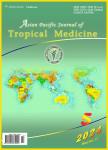Prevalence of filarial parasites in domestic and stray cats in Selangor State, Malaysia
Prevalence of filarial parasites in domestic and stray cats in Selangor State, Malaysia作者机构:Department of Parasitology Faculty of Medicine University of Malaya Department of Anesthesiology Faculty of Medicine University of Malaya
出 版 物:《Asian Pacific Journal of Tropical Medicine》 (亚太热带医药杂志(英文版))
年 卷 期:2015年第8卷第9期
页 面:693-697页
核心收录:
学科分类:090603[农学-临床兽医学] 1002[医学-临床医学] 09[农学] 0906[农学-兽医学]
基 金:funded by a Ministry of Higher Education Research Grant (FRGS FP011/2011A) the University of Malaya (PG085-2012B)
主 题:Filarial parasites Brugia Wuchereria Dirofilaria Cat Filariasis
摘 要:Objective: To determine the prevalence of the filarial parasites, ie., Brugia malayi, Brugia pahangi(B. pahangi), Dirofilaria immitis and Dirofilaria repens(D. repens)in domestic and stray cats. Methods: A total of 170 blood sample were collected from domestic and stray cats and examined for i larial worm parasites in two localities, Pulau Carey and Bukit Gasing, Selangor State, Malaysia. Results: The overall prevalence of infection was 23.5%(40/170; 95% CI=17.4–30.6). Of this, 35%(14/40; 95% CI=22.1–50.5) and 50%(20/40; 95% CI=35.2–64.8) were positive for single B. pahangi and D. repens, respectively. The remaining of 15%(6/40; 95% CI=7.1–29.1) were positive for mixed B. pahangi and D. repens. In addition, 75% of the infected cats were domestic, and 25% were strays. No Brugia malayi and Dirofilaria immitis was detected. Eighty-four cats were captured at Pulau Carey, of which 35.7%(30/84) were infected. Among the cats determined to be infected, 93%(28/30; 95% CI=78.7–98.2) were domestic, and only 6.7%(2/30; 95% CI=19.0–21.3) were strays. Conversely, the number of infected cats was three times lower in Bukit Gasing than in Pulau Carey, and most of the cats were stray. Conclusions: B. pahangi and D. repens could be the major parasites underlying i lariasis in the study area. Adequate prophylactic plans should be administrated in the cat population in study area.



